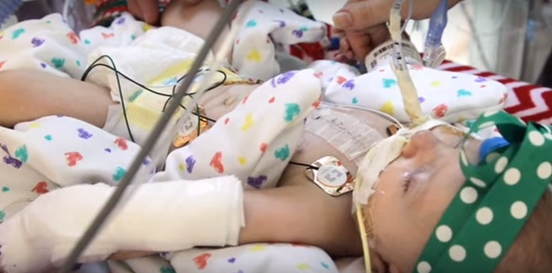Google Cardboard Saves Baby’s Life By Helping Doctors Perform Surgery

Teegan Lexcen was born a few months ago in Minnesota with a severe birth defect — missing half of her heart and one of her lungs. When doctors saw Teegan, they told her parents there was nothing they could do to save her. But after she survived for two months, her parents began wondering if there was someone else who could help her.
That's when they found Nicklaus Children's Hospital (NCH) in Miami, home to doctors famous for pediatric surgery. It was there the Lexcens found doctors who were willing to take a chance on their daughter — and the way they did it ended up being remarkable.
At NCH, doctors began making a plan to help her. Dr. Juan Carlos Muniz, a pediatric cardiologist, decided to make a 3D model of Teegan's heart to help doctors plan better, as there was almost nothing they could do with 2D images. When he discovered their 3D printer was broken, he turned to a $20 cardboard box — Google Cardboard to be exact, which is a small box that gives viewers the experience of virtual reality. It's almost toy-like in its simplicity, but can offer a complex view of 3D images.
Google Cardboard, in collaboration with an iPhone app called Sketchfab, allowed Muniz to see Teegan's heart in 3D. And this was more detailed and complex than 3D images on computer screens, as the Google Cardboard goggles allowed doctors to move around and glance at the heart from any angle. This way, they could visually plan out their surgery. The virtual images allowed Dr. Redmond Burke, chief of cardiovascular surgery at NCH, to make incisions for the surgery in the most effective and safe way — as well as perform the actual surgery once they were inside the ribcage.
"It was mind-blowing," Cassidy Lexcen, Teegan's mother, told CNN. "To see this little cardboard box and a phone, and to think this is what saved our daughter’s life."
Ultimately, the visual image from Google Cardboard remained in Burke's mind as he operated — and he contributes it to saving her life, as he knew what to expect when he saw her heart. "Sometimes that's what makes the difference between life and death," he told CNN.
Amazingly, for both Teegan and her family, she's in recovery and has been taken off the ventilator. Doctors expect her to be well soon.
Google has provided other gadgets that have been incorporated into the medical world. The Autism Glass Project at Stanford uses Google Glass to treat autism. The company has been working on developing a glucose monitor to help people deal with diabetes, and has even ventured into the land of health wristbands that communicate with doctors to keep track of patients' health.
Google Cardboard wasn't designed for medical purposes, but it's quite remarkable that these new technologies can be so seamlessly incorporated into the medical world.
Perhaps on a grander scale, the era of virtual reality potentially revolutionizing medicine is also nigh. Virtual reality has already been shown to assist in anxiety, autism, and PTSD treatments; as well as surgeries like Teegan's. To learn more about Google Cardboard and how it works, see the video below.



























